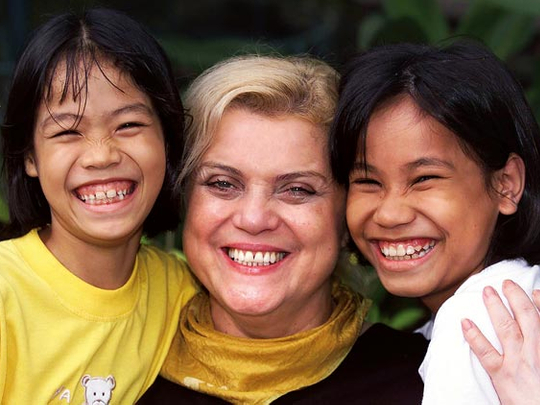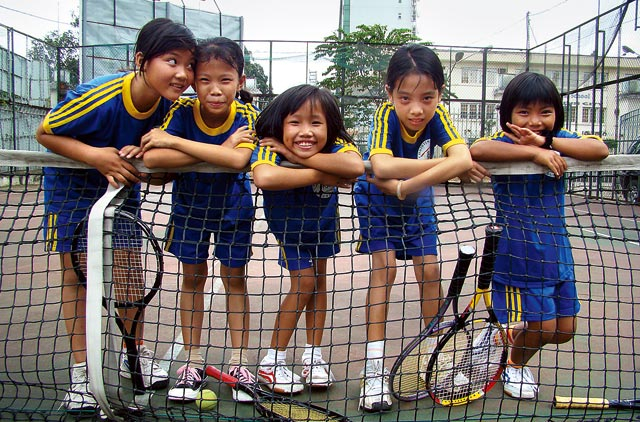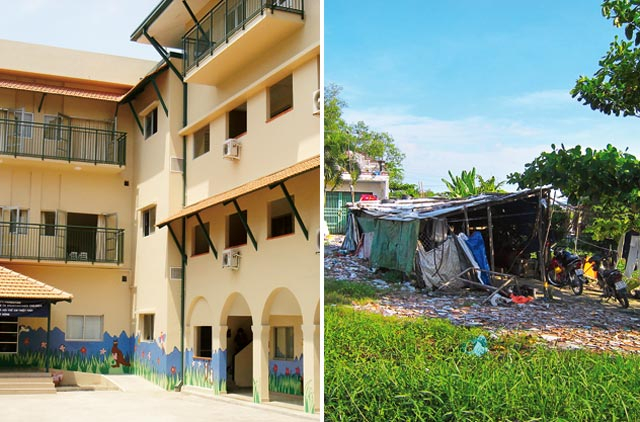
Most visitors to one of Vietnam’s most lauded foundations for children expect an air of sadness to permeate the light brown two-storey building. After all it’s not irrational – children rescued from the claws of biting poverty to be sheltered, loved and, in some cases, reborn is invariably a bitter-sweet tale. So it’s a surprise to discover such preconceptions are not akin to the ethos of the Christina Noble Children’s Foundation (CNCF), a sanctuary that, since its doors opened in 1991, has offered a new life to more than 600,000 of Vietnam’s disadvantaged young. Nestled in the busy District 3 at 38 Tu Xulong Street, in Ho Chi Minh City, it is a place where happiness, not sorrow, spills from the crevices of the building, where a sense of security and love bounce off the brightly coloured walls.
Entering the gates, stacks of bicycles line the shrub-entwined grills and children scamper past in a whirlwind of smiles and excited waves as they rush to bright classrooms in the Sunshine School. It’s hard to imagine these clean, neat, happy-looking, uniform-clad pupils once slept unaccompanied under bridges, on benches, or were locked in sweatshops, their malnourished bodies riddled with lice, scabies and dirt.
Now laughter drifts from the toy-strewn kindergarten while the leaves of the trees in the courtyard seem to dance to the soft tinkling notes of the piano wafting from the recreation room on the first floor.
But this picture-perfect scene didn’t spring up overnight nor without challenges. Despite seemingly insurmountable odds, the CNCF was established one painstaking day at a time, its roots firmly entrenched in resilience and a relentless belief in love.
“Poverty is not just a lack of money; it’s also about a lack of dignity, living in constant fear, and with little or no future to look forward to,’’ says founder Christina Noble. “No human being, especially a child, should endure a life of daily agonising grief, which is the case for almost all of the children and their families, who come to our foundation.”
Christina knows about their plight. Born into a life of poverty in Ireland, she was abandoned at the age of ten by an abusive father following the death of her mother. Left to fend for herself on the freezing streets of Dublin, she unwittingly adapted to a life of begging in a bid to provide for her three siblings. After being separated from them – the municipal authorities placed the siblings in different care centres – she had to endure a childhood that was the stuff of nightmares.
Tossed from one institution to the next through a blur of beatings and abuse, Christina entered adulthood troubled, damaged and in desperate need of psychological help. However, one thing that remained strong was her spirit. Resolutely defiant and refusing to allow the multitude of grim experiences from her past to manifest themselves in her future, she was determined to improve her life.
Into the unknown
When she became a mother, Christina fought to shelter her three children from the life of violence she had experienced, providing them, instead, with an environment of love she had never known. Only when she was safe in the knowledge that all three were well equipped to embark on independent lives did Christina turn her attention to realise her dream – one that came most nights in her sleep – of children running towards her, pleading for help, with the words ‘Vietnam’ appearing in the clouds.
In 1989, Christina decided to see what her dream meant and boarded a plane to Vietnam and into the unknown. With nothing more than a few dollars in her pocket, ineffable courage and a heart bigger than the Mekong River delta, the soon-to-be nicknamed Miss Saigon embarked on a journey that would not only shape her destiny, but change the lives of thousands of children forever.
Questions surrounding her calling were quickly answered when upon arriving at her hotel she saw two little girls, Hang and Huong, playing in the dirt. They were not playing, as she initially thought, but grubbing for ants and insects to eat. Christina did not have to think any further; she had found her raison d’être: to help the ‘bui doi’, the ‘dust of life’ as they were once known, the thousands of starving Saigon street kids moving without purpose like dust in the wind. Innumerable children live in dire poverty across Vietnam. Lack of basic shelter, a poor daily diet defunct of even the most basic nutritional requirements, desperately inadequate sanitation, limited access to any form of education, and a shortage of even the most rudimentary medical care are day-to-day obstacles for thousands.
Those born to poor rural families are dispatched at tender ages to toil the land in the misguided belief that accruing a minimal income will help alleviate the family’s needs. Uninformed parents see little benefit in granting their offspring access to what they
see as a fruitless education, when their child’s two hands are instrumental in putting a coveted meal on the table. Yet, despite the sacrifices, food is still a luxury ill afforded by many families.
Hunger in Vietnam remains endemic and recent statistics reveal one-third of all children below five are stunted as a result of chronic malnutrition. Children who survive on insects, plants and begging are everywhere across the country from the jungle to plantations, under city bridges, enslaved in sweatshops and curled up inside cardboard boxes.
The exact number of destitute children is unknown, but as Unicef points out, “Life is much better for the 26 million Vietnamese children than it was just two decades ago”. Today only 12 per cent of the population lives below the poverty line, down from 58 per cent in 1993. Vietnam’s economic growth and transition from being one of the poorest countries in the world is noteworthy, however, because, as is usually the case with rapid urbanisation, the divide between the ‘haves’ and the ‘have nots’ is widening.
Struggling to survive
Today poverty is still prevalent and abandoned, abused and exploited children are still common. Many struggle to survive alone while most have no choice but to live and work on the streets, selling lottery tickets, roses, or themselves to survive. But the CNCF opens its doors to these children; it is a haven that provides them with shelter, education, medical care, food and, importantly, love. As Christina says in her autobiography Mama Tina, “The feeling of being wanted is as important as any medical treatment”.
The foundation currently has 121 projects across Vietnam, ranging from kindergartens in remote areas, social and medical centres, schools, safe homes, sanitation programmes, and even a revolving loan programme to help people improve an existing businesses or set up new ones. The CNCF Medical and Social Centre (now The Centre for Social Assistance for Disadvantaged Children) was the first project. Initially intended as a base where mothers, babies and children could get free health care, today it incorporates an outpatient clinic that provides free, essential assistance for up to 1,000 children a month.
Government clinics in Vietnam are available and inexpensive, but to a family that earns barely Dh300 a month, such places are still woefully beyond their means. At CNCF, underprivileged patients are provided international-quality treatment for a wide variety of ailments, from surgery to treating the common cold. In a testimony to its diligence and successful treatment of so many with so little, the Vietnamese government recently showcased the centre as an example of what can and should be achieved by state-run medical clinics.
A ray of sunshine
Education is CNCF’s key objective. Breaking the cycle of poverty and educating families on the long-term benefits of sending their children to school instead of to the fields, is one of the primary challenges of the foundation. Although school in Vietnam is free, books, uniforms and transport are not. At the CNCF’s Sunshine School those who can’t afford an education are given assistance.
When it first opened its doors in 1991, 30 children enrolled. Today it can accommodate up to 300 children. This year the intake was 170, but Donna Burr, communications manager for the CNCF says, “We take that as a really positive sign that slowly children are being integrated into the public Vietnamese system.”
The school’s aim is to help at-risk children integrate into the regular curriculum and achieve a basic Grade 5, the final primary school certificate and a prerequisite for admission to vocational courses. Some Grade 1 pupils at the school are 11 years old, having missed five years of primary education.
Students are provided with free education, books, bags, and food, along with medical and dental check-ups. It’s not only education that is on offer at the school, physical and social expression are just as important and a lot of attention is given to sports, art and music competitions, equipping children with the skills needed to become well-rounded, productive citizens. And the children have been proving their success. Last year the school’s Grade 5 pupils achieved a 100 per cent pass rate with 95 per cent of them moving on to higher education. For those who choose to follow vocational courses, help is at hand to develop their special talents and skills.
One such student is Huynh Duc Phat. This teenage orphan and former street kid, who has flourished under the care of the CNCF’s Boys’ Shelter, started to show a flair for tailoring while in school. His talent was nurtured and Huynh is receiving extra English lessons so he can benefit from a once-in-a-lifetime opportunity that recently came his way.
A film crew will soon be in Vietnam to shoot a movie about the CNCF, and a Bafta award-winning costume designer has agreed to take Huynh under her wing. After the movie he hopes to complete an internship with one of Vietnam’s fashion designers and one day, become a renowned designer himself. As Christina Noble says, “No dream is too big”.
The Boys’ Shelter, which Christina describes in Mama Tina as, “...a nest, where children could shelter, stretch their wings, and eventually learn to fly,” was created in 1994 to provide a safe, loving environment for street kids. Today, two shelters exist, one for boys the other for girls, where they can reside in safety while the CNCF attempts to reunite them with their relatives.
Both serve as sanctuaries for around 25 children up to the age of 17, where, under the supervision of staff, the children are given a chance at a promising future. Here, they are safe from the streets where they remain at constant risk of starvation and exploitation.
Holding their heads up high
It’s a long-term support system which, as Christina says, is imperative “because that’s where the results come from. That’s what turns them into productive, healthy, decent adults. They do not depend on the state, they’re their own person, they have their dignity and they can hold their heads up high. They can look in the eyes of anyone else and say ‘I’m part of society, I’m part of the system, I’m part of living and I’m equal to all.’”
One of the beneficiaries of the shelter is Dinh. Legs crippled by polio, he moved to Ho Chi Minh from the countryside shortly after being abandoned by his mother who didn’t want to be burdened with him.
The 14-year-old travelled 600km on a makeshift skateboard, begging throughout the three-month journey to survive. Upon arrival, the helpless teenager fell victim to criminal gangs. It was two years later that the CNCF volunteers spotted him after he overdosed on illegal substances.
Christina knew that to get Dinh through drug rehabilitation and to repair the damage inflicted by his experiences, he needed to be in a shelter away from the streets. It was this chance encounter that triggered the creation of the shelter.
Under its care he soon was able to find work in a diamond factory and saved enough money to move into his own accommodation. Although still physically challenged, Dinh is very much on his own two feet, for the first time in his life.
The foundation, with its family of workers and donors, works around the clock to save children from a life of solitude, despair and desperation.
While a stronger child protection system is slowly being integrated into Vietnamese society, model foundations such as the CNCF carry out the vital role of changing lives, and thereby changing the country’s future generations.
The road ahead is still unclear; there is much work to be done and funding to be found, but in the meantime, Christina still has dreams of her own – to give all children a chance at childhood. For someone who started life impoverished on the dirty streets thousands of miles away in Dublin and years later stood by the Irish Prime Minister as he inaugurated the Christina Nobel Children’s Foundation, no dream is too big.
Patient Profile
Bé arrived at the centre bundled in a cotton shawl, discarded in a plastic bag on a collective farm in the jungle, she was agonisingly hanging on to life by a thread. At just a few months old, the helpless baby girl had already been exposed to a lifetime of tragedy.
Born on the street and abandoned by her mother, Bé was used by beggars to seek alms from dusk until dawn, kept silent with doses of tranquillising Valium until she was so dehydrated she was discarded to die.
When the baby was brought to the CNCF, having spent several days clinging to life alone in a bag, half eaten by maggots and suffering with acute septicemia, doctors in the special-care unit were not sure she would survive another day. But the fighter that she was, she did. Bé is just one example in a long list of abandoned, neglected and abused children who have been saved by the dedication, professionalism and genuine care of staff at the centre.
●You can read more about Bé’s story in Christina Noble’s autobiography, Mama Tina.
Tell us the story… Do you know of an individual, a group of people, a company or an organisation that is striving to make this world a better place? Email us at friday@ gulfnews.com or the features editor at araj@gulfnews.com














